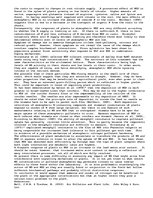Srivastava et al (1994) selected NO2 tolerant individuals of barley from NaN3 mutated seeds using very high concentrations of NO2. The survivors of this treatment had the same characteristics as the acclimated lettuce. Those characteristics being high levels of NR activity in their shoots and low levels in their roots. In other words, they are capable of using, and hence detoxifying, atmospheric NO2 while ignoring nitrate in the nutrient medium.
One possible flaw in these particular NOx-fixing mutants is the small size of their roots, which would suggest that they are sensitive to drought. However, they do have other properties that may be beneficial to agricultural yield, even when grown in clean air. They have an extended grain-filling period which is reflected in higher yields. This could be important in terms of improving plant productivity.
It has been demonstrated by Hanson et al (1989)* that the deposition of NO2 is much greater in broad-leafed trees than conifers. This may be due to the higher conductance to NO2 of the conifer forests floor or the impermeability of the cuticles of the conifer needles. The needles are also impermeable to dry deposition of HNO3. It should be noted that the principle site of deposition is inside the leaf or needle so the stomata have to be open to permit such flux (Wellburn, 1990). Both deposition velocities of atmospheric N-containing compounds and stomatal conductances of plants exposed to oxides of N show large variation, but there is one feature of such measurements relating to NO and NO2 that is undisputed: stomata have to be open for major uptake of these atmospheric pollutants to occur. Gaseous deposition of NO2 is much reduced when stomata are closed or when conifers are dormant (Hanson et al, 1989).
…



